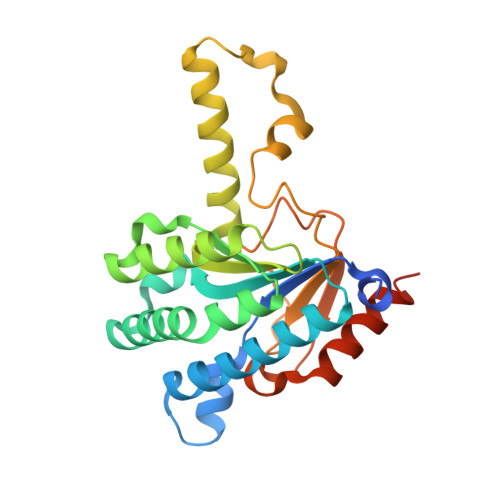Crystal structures of undecaprenyl pyrophosphate synthase in complex with magnesium, isopentenyl pyrophosphate, and farnesyl thiopyrophosphate: roles of the metal ion and conserved residues in catalysis.
Guo, R.T., Ko, T.P., Chen, A.P., Kuo, C.J., Wang, A.H., Liang, P.H.(2005) J Biol Chem 280: 20762-20774
- PubMed: 15788389
- DOI: https://doi.org/10.1074/jbc.M502121200
- Primary Citation of Related Structures:
1X06, 1X07, 1X08, 1X09 - PubMed Abstract:
Undecaprenyl pyrophosphate synthase (UPPs) catalyzes the consecutive condensation reactions of a farnesyl pyrophosphate (FPP) with eight isopentenyl pyrophosphates (IPP), in which new cis-double bonds are formed, to generate undecaprenyl pyrophosphate that serves as a lipid carrier for peptidoglycan synthesis of bacterial cell wall. The structures of Escherichia coli UPPs were determined previously in an orthorhombic crystal form as an apoenzyme, in complex with Mg(2+)/sulfate/Triton, and with bound FPP. In a further search of its catalytic mechanism, the wild-type UPPs and the D26A mutant are crystallized in a new trigonal unit cell with Mg(2+)/IPP/farnesyl thiopyrophosphate (an FPP analogue) bound to the active site. In the wild-type enzyme, Mg(2+) is coordinated by the pyrophosphate of farnesyl thiopyrophosphate, the carboxylate of Asp(26), and three water molecules. In the mutant enzyme, it is bound to the pyrophosphate of IPP. The [Mg(2+)] dependence of the catalytic rate by UPPs shows that the activity is maximal at [Mg(2+)] = 1 mm but drops significantly when Mg(2+) ions are in excess (50 mm). Without Mg(2+), IPP binds to UPPs only at high concentration. Mutation of Asp(26) to other charged amino acids results in significant decrease of the UPPs activity. The role of Asp(26) is probably to assist the migration of Mg(2+) from IPP to FPP and thus initiate the condensation reaction by ionization of the pyrophosphate group from FPP. Other conserved residues, including His(43), Ser(71), Asn(74), and Arg(77), may serve as general acid/base and pyrophosphate carrier. Our results here improve the understanding of the UPPs enzyme reaction significantly.
Organizational Affiliation:
Taiwan International Graduate Program, Academia Sinica, Taipei 115, Taiwan.

















